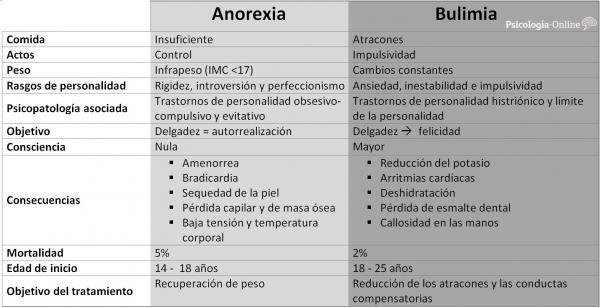
Eating behavior disorders present an approximate prevalence between 4.1% and 6.4%, especially affecting young women. Within this group of disorders, the best known diseases are anorexia and bulimia. By presenting a series of common characteristics, such as an alteration in eating patterns and a goal of weight loss, both diseases are often confused. However, they present a series of their own and distinctive characteristics. If you want to know the differences and similarities between anorexia and bulimia, keep reading this Psychology-Online article: 12 differences between anorexia and bulimia.
Index
- Eating disorder
- Anorexia and bulimia: definition
- 12 differences between anorexia and bulimia
- Differences between anorexia and bulimia: comparison chart
Eating disorder.
The eating disorders (eating disorders) they are a group of mental disorders of which both anorexia and bulimia are part. These are characterized by pathological behaviors
Eating disorders have a high mortality rate, constituting a public health problem, as well as a tendency towards chronification. They are disorders of multifactorial origin, that is, multiple factors affect their appearance and maintenance. However, in the last fifty years or so there has been an increase in the incidence and prevalence of disorders of the eating behavior, probably due to sociocultural factors of social pressure for image and beauty standards prevailing. Because of this, eating behavior problems are very more prevalent in adolescent and young women than in the rest of the population, since, although not exclusively, a large part of these messages from society are focused on this population sector.
Anorexia and bulimia: definition.
Anorexia and bulimia, categorized within the section of eating and eating disorders of the DSM-5, are described as follows:
Anorexia nervosa
According to DSM-5, anorexia nervosa is a psychological disorder characterized by intake restriction driving significantly less than normal body weight. In anorexia there is a distortion of the perception of one's body and weight to which, in addition, an exaggerated importance is given. Anorexia nervosa also features a disproportionate fear of gaining weight and behaviors to avoid it.
Bulimia nervosa
Bulimia nervosa appears in DSM-5 as a psychological disorder characterized by binge-eating episodes, in which a higher than normal amount of food is ingested, along with actions to compensate binge eating. Self-assessment is also influenced by the perception of one's own body and weight.
12 differences between anorexia and bulimia.
Among the similarities between bulimia and anorexia, we find that they are part of the same group of disorders, those of eating behavior, and that present alterations in both eating patterns and concern for image bodily. However, both diseases present a series of their own characteristics that differentiate them. The 12 differences between anorexia and bulimia are:
- Food behavior: The basic difference between anorexia and bulimia is that in anorexia there is a controlled restriction of intake, which can lead to fasting, while in the bulimia the affected person tries to restrict the amount of food or stop eating, but is not able to resist the desire for food and ends up incurring Binge. These binges are normally compensated by purgative behaviors such as vomiting and less frequently by excessive physical exercise or ingestion of laxatives. Therefore, anorexia is characterized by restriction and binge-eating bulimia in terms of behavioral symptoms.
- Control over eating behavior: in the case of anorexia there is a strict and methodical control of food restriction and in bulimia there is a loss of this in bingeing, there is a more emotional component and impulsive.
- The weight: Another difference between anorexia and bulimia is the body mass index (BMI), which is a method used to estimate the amount of fat in a person's body by dividing the weight in kilos by the height in meters raised to the square. The BMI is an indicative measure whose normal range is considered between 18.5 and 25. As for people with anorexia, they are underweight, usually a BMI less than 17, becoming less than 15 in extremely serious cases. On the other hand, people who suffer from bulimia usually have a weight within the normal range. In addition, bulimia is characterized by large fluctuations in weight, so that in binge seasons the weight will tend to increase and in periods of caloric restriction to decrease.
- Psychological profile: The traits associated with each of the disorders vary, since anorexia is characterized by control and order, and bulimia by emotionality and compulsiveness. Therefore, in general terms, the profile of people with anorexia is usually marked by perfectionism, rigidity, introversion and self-demanding, while that of those with bulimia due to impulsivity, anxiety, emotional instability and the tendency to addictions. As for the mental disorders associated with each of these diseases, anorexia is associated with obsessive-compulsive personality disorders and avoidant and bulimia with histrionic personality disorders Y personality limit.
- Disease goal: Although in both disorders the goal is to achieve thinness, the goals that drive people with anorexia and bulimia are different; people with bulimia want to achieve thinness to achieve happiness, while people with anorexia as a form of self-realization and identification with their own body.
- Illness awareness: Another difference between anorexia and bulimia is that people with anorexia tend to have little or no awareness of the disease and present denial of the disease. change, and people with bulimia tend to have a greater awareness of illness or insight although they do not usually consider the need for treatment for it.
- Distortion level: In both disorders there is body dissatisfaction and a search for thinness, even so the perceptual alteration and distortion of the image is greater in anorexia than in bulimia.
- Consequences of the disease: There is a negative impact on health in both bulimia and anorexia, although the consequences are more serious in the latter. Another difference between anorexia and bulimia is the consequences of each of them: in anorexia, amenorrhea occurs, that is, loss of menstruation, bradycardia or slower heart rate, dry skin, loss of hair and bone mass, low blood pressure and body temperature and appearance of lanugo, a very fine body hair that appears in the absence of fat in order to protect the Body. On the other hand, in bulimia there is a reduction in potassium levels that can cause cardiac arrhythmias, dehydration, loss of tooth enamel and calluses on the hands caused by vomiting and enlarged glands salivary.
- Mortality levels: Another difference between anorexia and bulimia is the crude mortality rate, which is higher in anorexia. Corresponding to 5% per decade, my bulimia 2%. Death can be both from complications associated with the disease and from suicide in both.
- Age of onset: Although both diseases usually appear at an early age, anorexia usually develops in people younger than the bulimia, during adolescence, between the ages of 14 and 18, and bulimia later, in the youth stage, between the ages of 18 and 25 years.
- Prevalence: Another difference between anorexia and bulimia is that the prevalence of bulimia is higher than that of anorexia, it is estimated that the former is between 1 and 1.5% and the latter 0.4%.
- Treatment objective: Finally, the approach to treatment is also one of the differences between anorexia and bulimia. The main and initial goal of treatment for anorexia nervosa is to regain weight until achieving a healthy one, while that of bulimia is the reduction of binge eating and compensatory behaviors later. Intervention in anorexia in many cases requires hospitalization, while in bulimia in significantly much lower levels.
Differences between anorexia and bulimia: comparative table.
A summary table of the differences in anorexia and bulimia explained above is shown below.

This article is merely informative, in Psychology-Online we do not have the power to make a diagnosis or recommend a treatment. We invite you to go to a psychologist to treat your particular case.
If you want to read more articles similar to 12 differences between anorexia and bulimia, we recommend that you enter our category of Clinical psychology.
Bibliography
- Acerete, D. M., Trabazo, R. L., & Ferri, N. L. (2010). Eating behavior disorders: Anorexia nervosa and bulimia nervosa. AEPED protocol. Chapter 7.
- American Psychiatric Association. (2014). DSM-5. Diagnostic and Statistical Manual of Mental Disorders. Madrid: Editorial Médica Panamericana, S.A.
- del Bosque-Garza, J. M., & Caballero-Romo, A. (2009). Psychiatric Considerations for Eating Disorders: Anorexia and Bulimia. Medical Bulletin of the Children's Hospital of Mexico, 66(5), 398-409.


